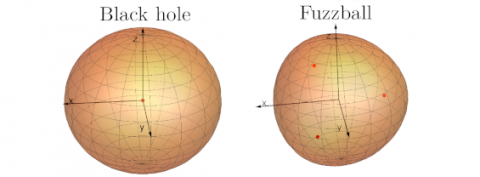Phenomenological imprints of the string-theory ‘fuzzball’ scenario

A collaboration between the gravity theory group at Sapienza University and the string-theory group at Tor Vergata University has found a way to observe some predictions of string theory with future detectors of gravitational waves. This study has been recently published in Physical Review Letters.
Within Einstein’s theory of General Relativity, the unique stationary solution of an isolated black hole is the Kerr spacetime, which has an extremely simple multipolar structure depending only on two numbers: namely its mass and spin.
In General Relativity, black holes have curvature singularities that --according to Penrose’s Cosmic Censorship-- are conjectured to be always covered by event horizons. At the quantum level, black holes behave as thermodynamical systems with the area of the event horizon and its surface gravity playing the role of the entropy and temperature, respectively. In fact a BH can evaporate emitting Hawking radiation. These properties give rise to a number of conceptual issues (most notably the information-loss paradox) that can be addressed in a consistent quantum theory of gravity such as string theory.
Within string theory smooth, horizonless geometries with the same mass, charges, and angular momentum as the corresponding black hole exist. These geometries represent some of the microstates of the black hole in the low-energy (super)gravity description. The existence of a nontrivial structure at the putative horizon scale is the essence of the fuzzball proposal, wherein the classical black hole picture emerges from an averaging procedure over a large number of microstates, or as a `collective behavior' of fuzzballs.
Fuzzballs evade the classical no-hair theorems for black holes: they can indeed break the axial and equatorial symmetry of the Kerr metric and have a much richer multipolar structure, which provides a portal to constrain fuzzball models phenomenologically.
In this recent work, the collaboration has developed a general method to extract the multipole moments of arbitrary stationary spacetimes and applied it to a large family of horizonless microstate geometries. The team found numerical evidence that all multipole moments are typically larger (in absolute value) than those of a Kerr black hole with the same mass and spin.
Current measurements of the quadrupole moment of black-hole candidates could place only mild constraints on fuzzballs, but future gravitational-wave detections of extreme mass-ratio inspirals with the space mission LISA will improve these bounds by orders of magnitude.
Reference:
“Distinguishing fuzzballs from black holes through their multipolar structure”,
Massimo Bianchi, Dario Consoli, Alfredo Grillo, Josè Francisco Morales, Paolo Pani, Guilherme Raposo
Phys. Rev. Lett. 125, 221601 (2020)
